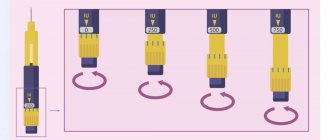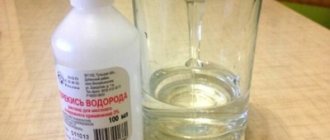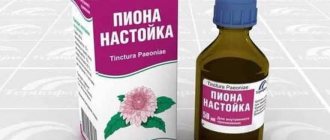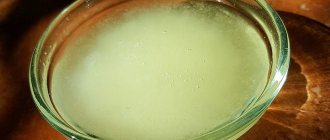From this article you will learn:
- what does Chlorophyllipt help with?
- how to dilute for gargling,
- reviews when used in ENT practice, price 2021.
The article was written by a specialist with higher medical education.
Chlorophyllipt is a herbal medicine with antimicrobial and antiseptic activity, which contains a mixture of chlorophylls from eucalyptus leaves. Chlorophyll is the pigment that gives the green color to the leaves of eucalyptus and other plants, and it is to this that the drug owes its name. The drug has the following forms of release: an oil or alcohol solution (contains ethanol), a spray form, and lozenges.
As we said above, chlorophyllipt has moderate antimicrobial activity, but it must be taken into account that it is mainly effective only against staphylococcus. Thus, the drug cannot boast a wide spectrum of antibacterial action, and it makes sense to use it primarily only as part of complex therapy. The drug also slightly stimulates regeneration processes (can be used for burns and trophic ulcers). When administered by inhalation, the drug slightly stimulates expectoration of sputum.
Chlorophyllipt: alcohol and oil solution
Chlorophyllipt spray and lozenges –
Forms of release of the drug –
- alcohol solution 1%,
- oil solution 2%,
- Spray for the throat,
- lozenges.
It should be noted that the drug has a fairly narrow range of indications for use. For example, the most popular alcohol form of the drug is not recommended for use in children under 18 years of age for oral administration (this means that the inhalation route of administration is also prohibited), as well as in pregnant and lactating women. In addition, inhalation of an alcohol solution is prohibited in case of atrophic processes in the mucous membrane of the upper respiratory tract, for example, in the atrophic form of chronic bronchitis, as well as bronchial asthma, bronchospasm.
It should be noted that Chlorophyllipt’s instructions for use of the drug are very sparse and do not contain detailed treatment regimens for diseases of the ENT organs. Therefore, patients look for information mainly on forums, where the “authors” sometimes recommend adding alcoholic Chlorophyllipt even to breast milk for newborns!!! Most of the harm has been written about the use of the alcohol form of the drug for inhalation, although courses of inhalation with alcohol solutions (especially in children) lead to atrophy of the ciliated epithelium of the bronchi, which, on the contrary, only contributes to the development of chronic bronchitis. As for the oil form of the drug, inhalations with it cannot be done in children under 2 years of age.
What is Chlorophyllipt used for?
Chlorophyllipt in tablet form is prescribed for diseases of the upper respiratory system, as well as for stomatitis. The solution is prescribed after surgery, childbirth, or infection. Indications also include:
- pneumonia;
- pleurisy;
- gynecological pathologies;
- burn disease;
- peritonitis.
Parenteral use of the drug is effective for tuberculosis and erysipelas.
The product helps with persistent wounds and soft tissue defects.
The instructions also indicate other indications for use depending on the form of the drug.
Chlorophyllipt: price and composition analysis
For Chlorophyllipt spray the price for 2021 will be about 210 rubles (for a 45 ml bottle equipped with a spray nozzle). The cost of a 2% oil solution will be from 150 rubles per 20 ml bottle. For a 1% alcohol solution of Chlorophyllipt, the price starts from 240 rubles (for a 50 ml bottle). As for lozenges, the cost of 1 package of 20 tablets starts from 150 rubles.
The drug Chlorophyllipt is produced by several manufacturers, but regardless of this, the main component of the drug always remains the extract of eucalyptus leaves - in the form of essential oil. The value of eucalyptus oil is determined by the content of a substance called “Cineol”, which gives the drug an antimicrobial and expectorant effect. Some other properties of this drug, which are beautifully described in the instructions (for example, accelerating wound healing) do not have much therapeutic value, because This effect of the drug is rather weak.
It should be noted that the content of cineole in eucalyptus oil is not constant and depends - 1) on the type of eucalyptus oil that the manufacturer uses, 2) on the concentration of eucalyptus oil in the drug solution. In addition to cineole, eucalyptus essential oil also contains other substances: chlorophyll, organic acids, aldehydes, tannins (about 6%), as well as useful trace elements, such as selenium, zinc and manganese. It should be noted that the reviews for the drug Chlorophyllipt are mostly positive, but as you will see below, the drug deserves attention only as part of complex therapy. Below we will consider in order all forms of release of this drug.
How to take Chlorophyllipt for children
The instructions for the drug do not contain clear recommendations regarding its use in childhood. The manufacturer claims that there is not yet sufficient experience in taking the medication in the treatment of children.
But since the drug is well tolerated by the body and rarely causes adverse reactions, it is often prescribed to children.
The oil solution can be used for colds and sore throat. They also have their nose dripped and their throat treated.
The solution can be used to treat wounds and cuts. In adolescence, it helps fight skin rashes.
Spray Chlorophyllipt: reviews, instructions
Chlorophyllipt-Vialine spray (manufactured in Armenia) is a combined drug for local use in the oral cavity (for the treatment of tonsillitis and pharyngitis), but can also be used to treat the nasal cavity for rhinitis. Available in 45 ml bottles with a spray nozzle. The spray is a green liquid with a characteristic odor. Does not contain alcohol.
Composition of Chlorophyllipt spray (Vialine):
| Active substances – → extracts of medicinal plants (eucalyptus leaves, stinging nettle, St. John's wort, wormwood, dubrovnik) |
| Excipients: purified water, sodium benzoate. |
→ Spray Chlorophyllipt: instructions for use (download in PDF)
Indications and regimen of use - indicated for infectious and inflammatory ENT diseases in adults (tonsillitis, pharyngitis, rhinitis). Studies have not been conducted in children, so use with caution. Make two presses on the spray nozzle, directing it to the tonsils/throat area. Apply 3 times a day. After spraying, it is advisable not to swallow saliva for as long as possible (preferably 2-3 minutes). The course of application is usually up to 10-12 days.
The official instructions also contain indications for use for stomatitis, but we do not recommend this. The fact is that the cause of aphthous stomatitis is most often an allergy, for example, to food, medications, herbal ingredients, etc. At the same time, Chlorophyllipt itself is a highly allergenic drug and can cause a worsening of the condition in some patients.
Pharmacological properties of the drug Chlorophyllipt
Chlorophyllipt belongs to the pharmacotherapeutic group of antiseptic drugs. The drug has an antibacterial (bactericidal and bacteriostatic) and etiotropic effect against resistant and sensitive staphylococci to antibiotics. It has the ability to eliminate plasmids of resistance of various bacterial pathogens to antibiotics, increases the oxygen content in tissues, and has a pronounced detoxifying effect, therefore the drug is used in conditions of reduced natural defenses of the body, as a means of combating tissue hypoxia and to increase the effectiveness of antibacterial drugs used. An experimental study of chlorophyllipt revealed the tropism of this drug for lung tissue, and the absence of any carcinogenic, mutagenic, teratogenic and embryotoxic effects. The bactericidal concentration of chlorophyllipt in the blood is created by the simultaneous intravenous administration of 8 ml of a 0.25% solution, the bacteriostatic concentration is created by 4 ml of a 0.25% solution. The therapeutic concentration lasts for an average of 6 hours; the optimal dose is to administer the drug 4 times a day.
Indications for use of the drug Chlorophyllipt
Staphylococcal septic conditions (postpartum, postoperative, postinfectious), purulent-inflammatory and postoperative complications of staphylococcal etiology: with burn disease, staphylococcal endocarditis, pneumonia, lung abscess, pleurisy, peritonitis, osteomyelitis, para- and metroendometritis, post-abortion sepsis, as well as acute and subacute inflammatory diseases of the internal genital organs not associated with childbirth or abortion, purulent-destructive forms of pyelonephritis and urosepsis (as part of complex therapy). For diseases caused by non-staphylococcal antibiotic-resistant pathogens (in particular for the treatment of erysipelas, tuberculosis of various localizations, listeria infection). Diseases of the upper respiratory tract (tonsillitis, pharyngitis, laryngitis), as well as aphthous and ulcerative stomatitis.
Chlorophyllipt alcohol: instructions, reviews
In pharmacies you will find a 1% alcohol solution of Chlorophyllipt from two manufacturers - either Russian or Ukrainian (available in bottles of 25, 50 and 100 ml). The contents of the bottles are a transparent green liquid with a characteristic odor. Keep in mind that sediment may form at the bottom of the bottle, which is not a violation and will only require shaking the bottle before diluting the drug in water.
The drug produced by Vifitech CJSC (composition) –
Chlorophyllipt alcohol: composition
| Active substances (per 1000 ml) – → thick chlorophyllipt extract (eucalyptus leaf extract) – 10.0 g, which in percentage terms corresponds to 1% concentration of the extract in an alcohol solution. |
| Excipients - the rest of the volume is 95% ethyl alcohol. |
→ Chlorophyllipt alcohol solution: instructions (download in PDF)
Indications for use - the drug can be used for gastrointestinal diseases caused by staphylococcus, some forms of enterocolitis, gastritis with reduced secretion, cervical erosions, as well as for the treatment of trophic ulcers and burns. Chlorophyllipt alcohol, when diluted with water, can also be used for rinsing the mouth (to achieve a deodorizing effect). Can also be used to treat skin with dermatitis.
For diseases of the ENT organs - this indication is not included in the official instructions for use, but nevertheless this drug is sometimes prescribed in complex therapy for diseases of the respiratory system (rhinitis, bronchitis, pneumonia, laryngitis) by inhalation, for example, using a nebulizer or inhaler. Below we will explain why these indications are not in the official instructions, and the dangers of their implementation - especially in children.
Usually on forums it is recommended to dilute a 1% alcohol solution of the drug with saline solution in adults - 1:4, in children - up to 1:10. It is recommended to use the solution in a nebulizer or inhaler 3 times a day (3-4 ml of the resulting solution at a time). And all this despite the fact that the instructions for the alcohol solution clearly state that it is contraindicated for people under 18 years of age. But let's look at what complications the use of an alcohol solution of Chlorophyllipt can lead to.
Alcohol vapor during a course of use leads to thinning of the bronchial mucosa, including the transformation of columnar epithelium into flat epithelium, the ciliary apparatus contracts + the bronchial glands are replaced by fibrous tissue. The bronchial epithelium in children is especially sensitive to this effect. And this means a slow and steady movement towards chronic atrophic bronchitis. In addition, the drug should absolutely not be used for bronchial asthma, bronchospasm, asthmatic bronchitis at any age.
Important: in addition to the sclerosing effect on the bronchial glands and the destruction of the ciliated epithelium, other side effects are possible when using this drug. Given its high allergenic potential, as well as the inhalation route of exposure, there are –
- allergies (often),
- swelling of the mucous membrane of the respiratory tract (often),
- suffocation (rare),
- nausea and vomiting (rare),
- dryness of the mucous membrane of the respiratory tract, as well as an associated dry cough (often).
Side effects, contraindications –
It is possible to be allergic to chlorophyll or other components of eucalyptus oil. Use with caution in people with allergic reactions. Ingestion of high dosages of the drug can lead to vomiting, diarrhea, nausea, and muscle spasms. Frequent/long-term use of the drug for inhalation can lead to thinning and dryness of the mucous membranes of the respiratory system, atrophy of the bronchial mucosa (with the development of chronic atrophic bronchitis).
Under no circumstances should the drug be used by inhalation for bronchial asthma, bronchospasm, asthmatic bronchitis, chronic atrophic bronchitis. There are contraindications for use in the oil form for inhalation - in children under 2 years of age, and in the alcohol form - in children under 18 years of age. Cannot be used orally for hyperacid gastritis. An alcohol solution should not be used for rinsing if the mucous membrane of the mouth and throat is dry and thin (24stoma.ru).
Important: before starting to use any form of Chlorophyllipt, you must first check the body's sensitivity to this drug. To do this, the patient must dissolve 25 drops of Chlorophyllipt alcohol solution in 1 tablespoon of water and drink. Or take 10 drops of oil solution. If after 6-8 hours there is no allergic reaction, you can start using the drug. An allergic reaction can also manifest itself on the skin.
Clinical studies of Chlorophyllipt –
As a well-educated doctor who reads a lot of scientific research, I would like to add a few more words. You will be surprised, but in the scientific literature you will not find a single clinical scientific article devoted to Chlorophyllipt, as well as not a single decent clinical study that would involve a comparison with a control group (placebo). All the information that can be found is mainly on the development of chlorophyll-based drugs (on behalf of pharmaceutical companies). All that was found was a scientific article devoted in general to the antimicrobial activity of chlorophylls, of which Chlorophyllipt is also composed.
The article “Antimicrobial activity of preparations containing chlorophylls” was published in 2013 (edited by Zhumabekov S.A. and Aisanov A.K.). It is worth noting that the article seriously argues that the antimicrobial activity of chlorophylls is comparable to antibiotics, but it does not provide a single comparative clinical study or any other evidence-based argumentation. Thus, it can be stated that from the point of view of evidence-based medicine, the effectiveness of the drug is in question. We hope that our article was useful to you!
Sources:
1. “Otorhinolaryngology. Textbook" (Palchun, Magomedov), 2. "Propaedeutics of internal diseases" (Grebenev A.L.), 3. Scientific works published on the website - https://cyberleninka.ru/, 4. https://ru.wikipedia .org/, 5. https://www.vidal.ru/.
Chlorophyllipt for gargling: how to dilute
An alcohol solution of Chlorophyllipt is often recommended for gargling.
The drug does have moderate antimicrobial activity, but only against staphylococci. This means that it makes sense to use the drug only, for example, for purulent tonsillitis (in this case, staphylococcus will actually be sown in the microflora). For other bacteria that cause inflammation of the tonsils and throat, rinsing with Chlorophyllipt will only have a slight deodorizing effect. How to dilute Chlorophyllipt for gargling - instructions for using the drug for throat recommend diluting 1 teaspoon of Chlorophyllipt alcohol solution in half a glass of warm boiled water. Moreover, you need to rinse your mouth for 5 minutes per procedure (since the drug is quite weak). Those. During the procedure, you will need to repeatedly draw up and spit out the diluted solution of the drug. Rinsing is carried out 3-4 times a day, preferably no more than 4-5 days.
Such a modest duration of use is due to the fact that alcohol solutions greatly dry out the oral mucosa and lead to its thinning. In addition, please note that the alcohol form of the drug is prohibited for use in children under 18 years of age. In fact, we would never recommend that anyone rinse their mouth with an alcohol solution of this drug. If you decide to use it, then it is better to use Chlorophyllipt spray, which does not contain alcohol. Due to the absence of alcohol, the spray can be used for a long time and often, and besides, the drug does not require dilution and is ready for use.
Chlorophyllipt in lozenges –
Chlorophyllipt for the throat in the form of an alcohol or oil solution has another alternative. These are Chlorophyllipt tablets for resorption. They are produced by two Russian manufacturers. Firstly, these tablets (Russia) are produced in 0.025 g (20 tablets per package) at a price of 120 rubles. The second, which produces lozenges of 0.8 g (20 tablets per package) at a price of 140 rubles.






